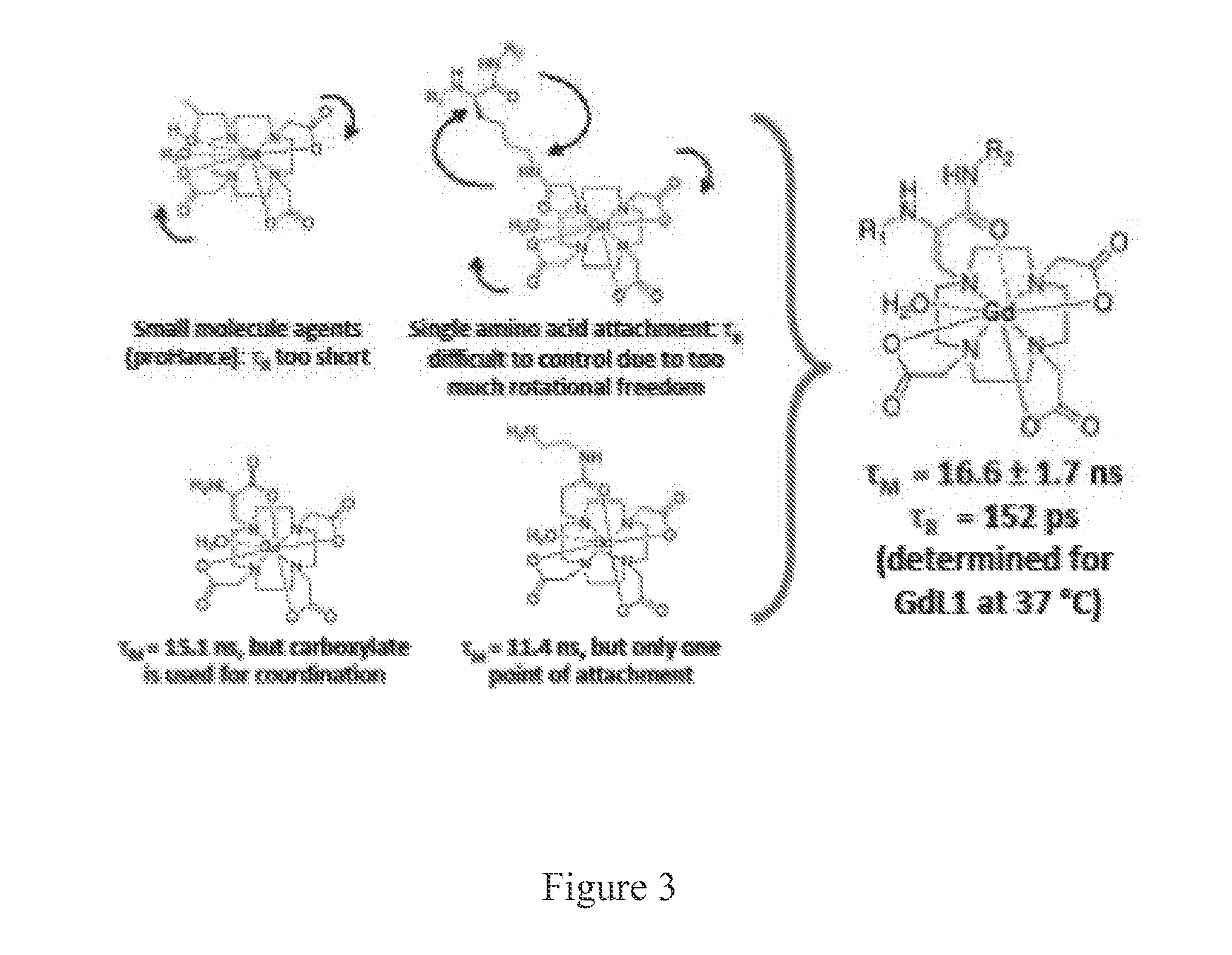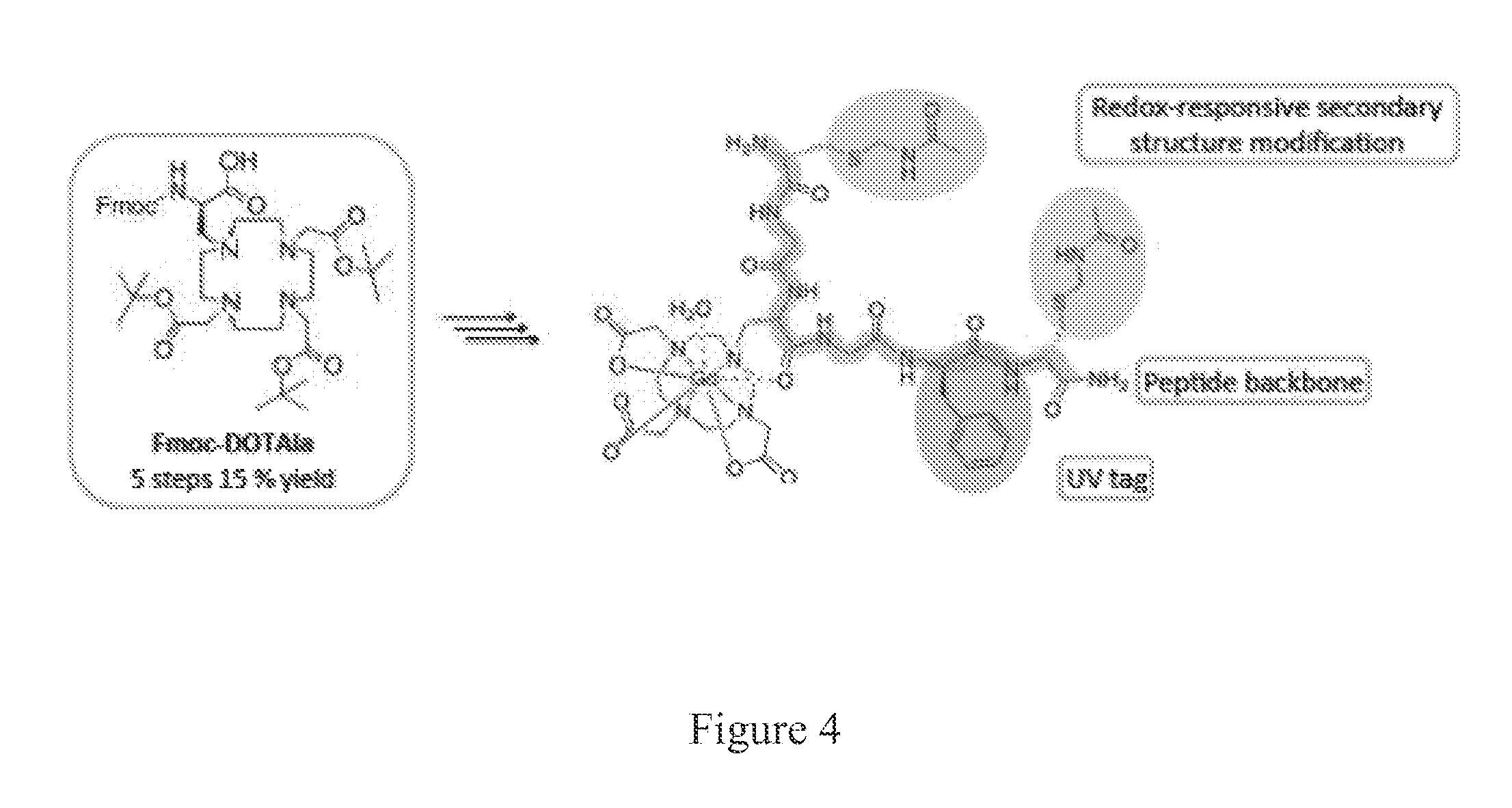Peptidic structures incorporating an amino acid metal complex and applications in magnetic resonance imaging
a technology of amino acid metal complex and magnetic resonance imaging, which is applied in the field of contrast agents, can solve the problems of reducing limiting relaxivity, and increasing q requires a reduction in available ligand donors, so as to increase the relaxivity of contrast agents, reduce the cost of thermodynamic stability and kinetic inertness, and reduce the effect of local motion
- Summary
- Abstract
- Description
- Claims
- Application Information
AI Technical Summary
Benefits of technology
Problems solved by technology
Method used
Image
Examples
example 1
[0122]This example discloses the use of a single amino acid Gd-complex as a modular tool for high relaxivity magnetic resonance (MR) contrast agent development.
[0123]Introduction. MRI at high magnetic fields (B0) benefits from an increased signal to noise ratio. For MR probes based on gadolinium (Gd, T1 agents), the inherent relaxivity of tissue also increases with increasing B0. Thus, if probe relaxivity (r1) is field independent, the sensitivity of Gd-based probes should increase with B0. Unfortunately, r1 typically decreases with B0 faster than the increase in baseline T1. However, by controlling the rotational dynamics (τR) of the probe, it is possible to create high relaxivity probes with high r1 at high fields (see FIGS. 1 and 2).
[0124]Concept. In order to optimize τR and τM for Gd-based high field imaging, we sought a system with an optimal τM and a tunable τR. Gd(DO3A-monopropionate) metal complexes have a near optimal τM in the range of 10-30 ns. Derivatization of the propi...
example 2
References for Example 2
[0193]1. Young, I. R., Methods in Biomedical Magnetic Resonance Imaging and Spectroscopy. John Wiley & Sons Ltd.: Chichester, 2000.[0194]2. Caravan, P., Acc. Chem. Res. 2009, 42, 851-862.[0195]3. Caravan, P.; Ellison, J. J.; McMurry, T. J.; Lauffer, R. B., Chem. Rev. 1999, 99, 2293-2352.[0196]4. Caravan, P., Chem. Soc. Rev. 2006, 35,512-523.[0197]5. Mastarone, D. J.; Harrison, V. S. R.; Eckermann, A. L.; Parigi, G.; Meade, T. J., J. Am. Chem. Soc. 2011, 133, 5329-5337.[0198]6. Garimella, P. D.; Datta, A.; Romanini, D. W.; Raymond, K. N.; Francis, M. B., J. Am. Chem. Soc. 2011, 133, 14704-14709.[0199]7. Kielar, F.; Tei, L.; Terreno, E.; Botta, M., J. Am. Chem. Soc. 2010, 132, 7836-7837.[0200]8. Costa, J.; TOth, E.; Helm, L.; Merbach, A. E., Inorg. Chem. 2005, 44, 4747-4755.[0201]9. Aime, S.; Frullano, L.; Crich, S. G., Angew. Chem. Int. Ed. 2002, 41, 1017-1019.[0202]10. Terreno, E.; Castelli, D. D.; Viale, A.; Aime, S., Chem. Rev. 2010, 110, 3019-2042.[0203]11...
example 3
[0245]This example discloses experimental data for DOTAla modular human serum albumin (HSA) binders.
General Methods and Materials
[0246]1H and 13C NMR spectra were recorded on a Varian 500 NMR system equipped with a 5 mm broadband probe. Longitudinal relaxation times, T1, were measured by using the inversion recovery method on Bruker Minispecs. mq20 (20 MHz) and mq60 (60 MHz). Purification via HPLC of intermediates toward Fmoc-DOTAla was performed using method A: Injection of crude mixture onto preparative HPLC on a Rainin, Dynamax (column: 250 mm Kromasil C18) by using A: 0.1% TFA in water, B: 0.1% TFA in MeCN, flow-rate 15 mL / min, 1 over 23 minutes. HPLC purity analysis (both UV and MS detection) was carried out on an Agilent 1100 system (column: Phenomenex Luna, C18(2) 100 / 2 mm) with UV detection at 220, 254 and 280 nm by using a method B: A gradient of A(0.1% formic acid in water) to 95% B(0.1% formic acid in MeCN), flow-rate 0.8 mL / min, 1 over 15 minutes.
[0247]In order to measur...
PUM
| Property | Measurement | Unit |
|---|---|---|
| Time | aaaaa | aaaaa |
| Wavelength | aaaaa | aaaaa |
| Wavelength | aaaaa | aaaaa |
Abstract
Description
Claims
Application Information
 Login to View More
Login to View More - R&D
- Intellectual Property
- Life Sciences
- Materials
- Tech Scout
- Unparalleled Data Quality
- Higher Quality Content
- 60% Fewer Hallucinations
Browse by: Latest US Patents, China's latest patents, Technical Efficacy Thesaurus, Application Domain, Technology Topic, Popular Technical Reports.
© 2025 PatSnap. All rights reserved.Legal|Privacy policy|Modern Slavery Act Transparency Statement|Sitemap|About US| Contact US: help@patsnap.com



